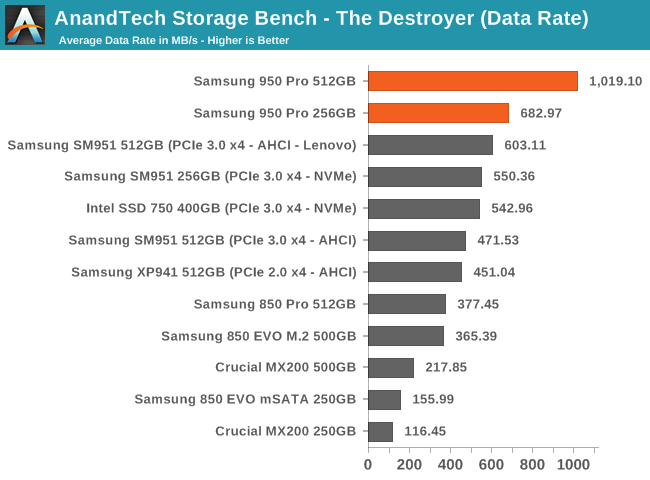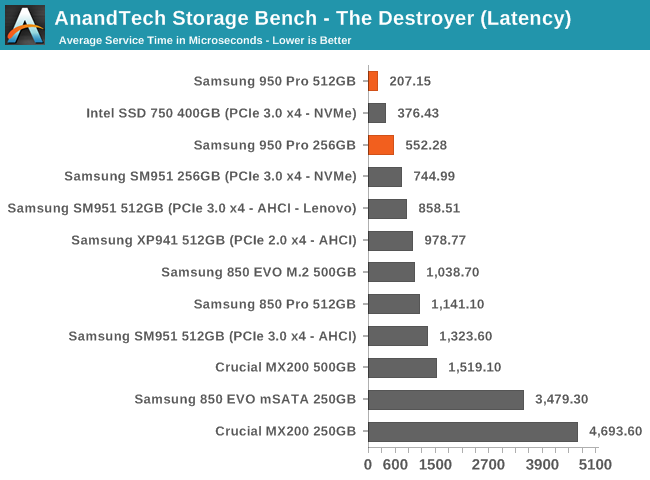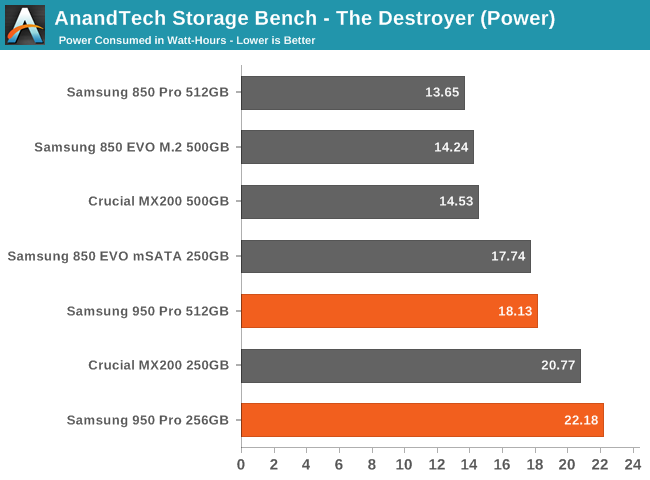The Samsung 950 Pro PCIe SSD Review (256GB and 512GB)
by Billy Tallis on October 22, 2015 10:55 AM ESTAnandTech Storage Bench - The Destroyer
The Destroyer is an extremely long test replicating the access patterns of heavy desktop usage. A detailed breakdown can be found in this review. Like real-world usage and unlike our Iometer tests, the drives do get the occasional break that allows for some background garbage collection and flushing caches, but those idle times are limited to 25ms so that it doesn't take all week to run the test.
We quantify performance on this test by reporting the drive's average data throughput, a few data points about its latency, and the total energy used by the drive over the course of the test.

Both 950 Pros deliver great performance on the destroyer, but the 512GB is outstanding. Clearly the more bursty nature of this test allows the drive to avoid any thermal throttling and deliver the high peak speeds that the PCIe interface is supposed to enable.

The NVMe drives deliver the lowest average service times, but the other PCIe drives are close behind. If there were any moments of thermal throttling like we saw with the performance consistency test, they would greatly inflate the average service time.

The very small number of performance outliers on this test is a good indicator that these drives don't sieze up under the pressure of an interactive workload.

When looking at the more strict latency threshold of 10ms, the 256GB 950 Pro is not significantly better than the good SATA drives, but the 512GB has extremely good control over latency.

Energy usage is not competitive with the high-performance SATA drives. As demanding as it is, The Destroyer still has opportunities for drives to scale back power consumption but the 950 Pro can't do that on our testbed.










142 Comments
View All Comments
user_5447 - Thursday, October 22, 2015 - link
Yeah, just buy Skylake motherboard, CPU and DDR4 RAM.And I'm not saying that it's simple, I'm saying that it's possible. You don't have to do anything special after setting it up, just keep small USB drive plugged in at the back of your PC.
user_5447 - Thursday, October 22, 2015 - link
Also, you can do it without additional USB drive, if you have at least one installed SATA device.Redstorm - Thursday, October 22, 2015 - link
Still a crap solutionEssence_of_War - Thursday, October 22, 2015 - link
I have had exactly two problems with GRUB.1) When windows destroys it because lolz.
2) When I was trying to install gentoo into a zfs root with on a luks encrypted disk.
Grub is fine and has been for a while.
SyukriLajin - Friday, October 23, 2015 - link
windows shouldn't be able to mess with it if grub is installed on an external usb drive, and then setting the usb drive as the main boot device(all bios i've seen supports this). it's called chainloading, and it's not a bad hack if you don't have all the proper hardware but still want to try it. of course, it will require some technical knowledge. and because i'm poor, and can't afford a new system, if it works, it's good enough.hero4hire - Sunday, October 25, 2015 - link
If you're poor you wouldn't buy a nvme ssd. It is interesting to talk possibilities thoughEwitte12 - Saturday, October 24, 2015 - link
It didn't take much to figure out how to insert the nvme modules into a z87 motherboard. However I was prepared to replace it with a z97 if it messed up. I was NOT even considering the 600+ to go to skylake.Redstorm - Thursday, October 22, 2015 - link
Because what you propose is not a very good solution at all.eddieobscurant - Thursday, October 22, 2015 - link
The problem with that theoretical solution (which i've tried) is that windows won't let you install on it when it lists the disk drives.If you migrate an installation from a sata drive, you get a bsod upon restart due to the different ahci/nvme drive required similar to the ahci/ide for sata drives.
So there isn't a solution
Gigaplex - Thursday, October 22, 2015 - link
You'd need to use the Windows deployment tools such as DISM to apply the WIM file, rather than run the regular install wizard.